Two hours after landing at Sarajevo Airport, I found myself sitting at an outdoor café in the historic Baščaršija quarter of Sarajevo. I’d decided to kick off my first visit to Sarajevo with a wander around the Old Town but after less than an hour, I quite literally felt overwhelmed! It was clear to me that there are lots of things to do in Sarajevo, but all I wanted to do, there and then, was find a spot to sit quietly, and soak it all in.
A maze of streets and alleys, Baščaršija, founded by the Ottomans in the 16th century, is the oldest and most touristy quarter in the city. Against a backdrop of minarets and domes, and rows of alfresco cafés and colourful shops, it’s a bustling area with many tourists, and just as many locals sipping coffee, eating a pastry, and mingling with family and friends. As I enjoyed my drink, the scent of freshly baked bread drifted through the air, mingling with the melodic call to prayer from a nearby mosque and the distant clang of church bells. The atmosphere was magnetic. I knew then this was a trip I’d never forget.
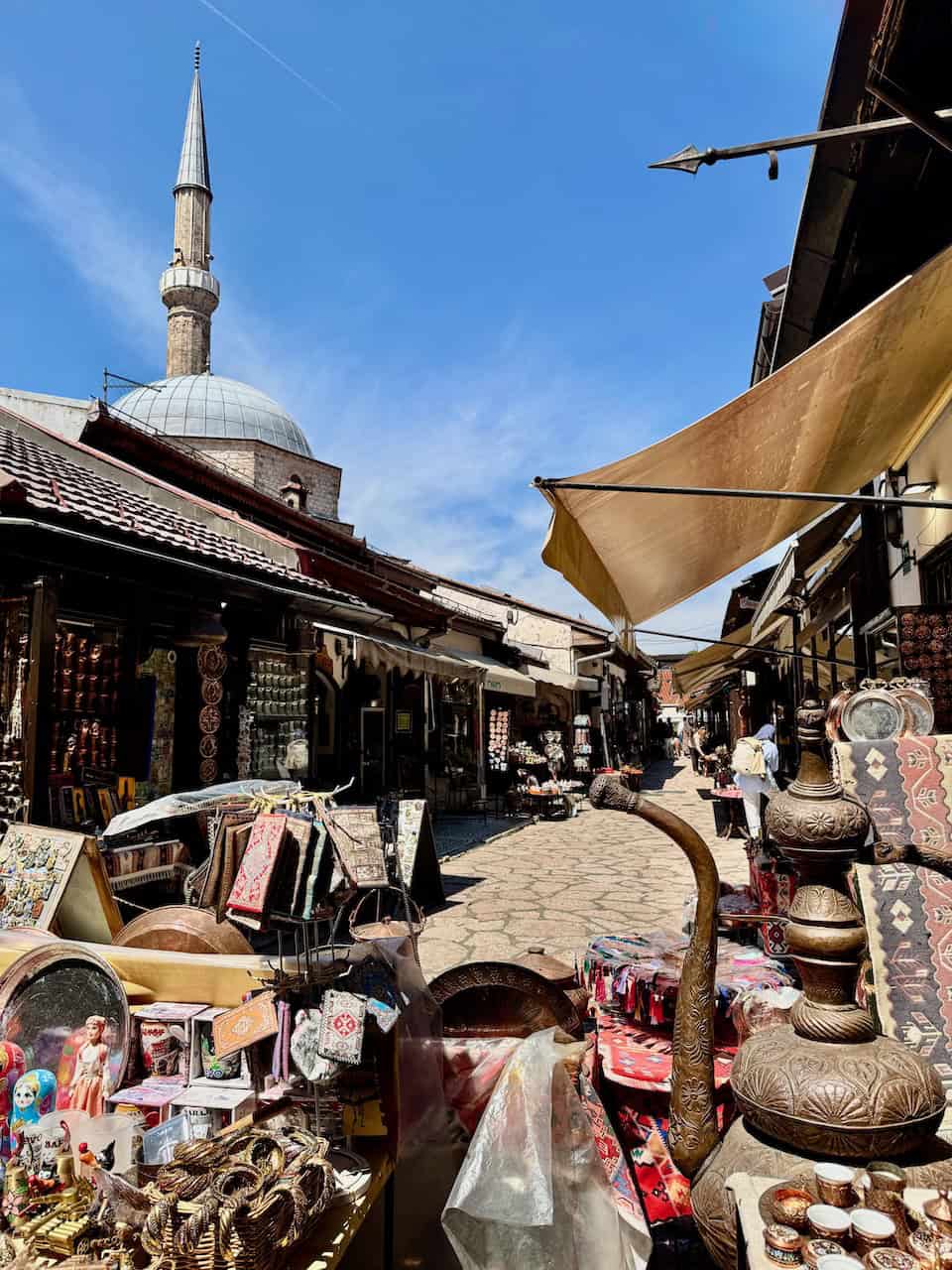

Sarajevo (map), the capital of Bosnia and Herzegovina, is situated in a valley on the banks of the Miljacka River and is surrounded by the forested mountains of the Dinaric Alps. I didn’t know a lot about Sarajevo before my arrival so I couldn’t wait to explore the city.
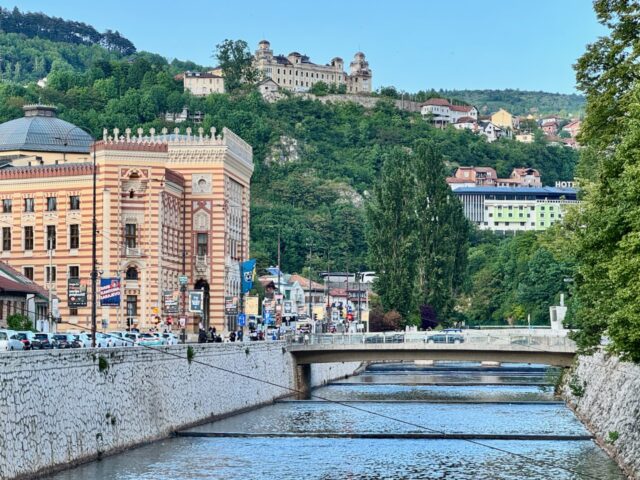
After spending a week of soaking up the city’s culture and history, with several day trips from Sarajevo in between, I was convinced that Sarajevo is absolutely worth visiting and that I would one day return. The city is a tantalising mix of Eastern and Western cultures, that stems from its occupation by the Ottomans (from the 15th century) and by the Austro-Hungarian Empire (1878). It’s often called the “Jerusalem of Europe” as there are mosques, synagogues, Catholic and Orthodox churches all located within a small area. In addition, the Bosnian people are warm and welcoming, which made me feel right at home.
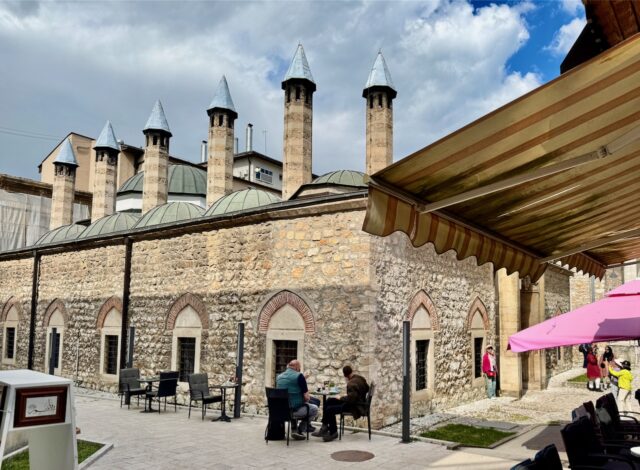
There are lots of things to do in Sarajevo so it was a challenge to pick the most interesting bits, but here we go (I’ve also pinned these places on a map below):
1. Explore Baščaršija
Baščaršija is the Ottoman-era Old Town. Its atmospheric streets and alleys, filled to the brim with historic monuments, shops, eateries and cafés, is a joy to explore! For an insightful introduction, I recommend joining the free walking tour, offered twice a day by Meet Bosnia, or a paid guided tour that covers more ground.
If you’d like to wander around on your own, make sure to look out for:
Sebilj fountain and ‘Pigeon Square’
An Ottoman-era wooden fountain on a square nicknamed ‘Pigeon Square’ by locals. A local legend says that if you drink from the fountain, you’ll return to Sarajevo one day! It’s no surprise that most visitors consider it one of the top things to do in Sarajevo!

Kazandžiluk
The oldest street in Sarajevo, renowned for its metalware, may seem touristy at first glance, but many of its shops are family-owned, with craftsmanship passed down through generations.
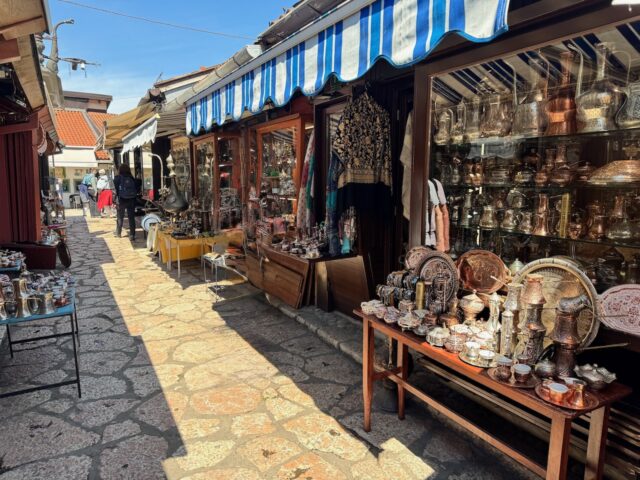
Gazi Husrev-beg Mosque
As you wander through Sarajevo’s Old Town, the name Gazi Husrev-beg appears often, and for good reason. A prominent Ottoman governor in the 16th century, he was known not only for his military campaigns in Croatia and Hungary but also for the urban development of Sarajevo. Before his death, he established a charitable endowment that funded the construction of many significant buildings throughout the city. One of the most remarkable is the Gazi Husrev-beg Mosque, the largest Ottoman-era mosque in Bosnia and Herzegovina. Its elegant fountain, a serene centerpiece of the courtyard, is especially beautiful.
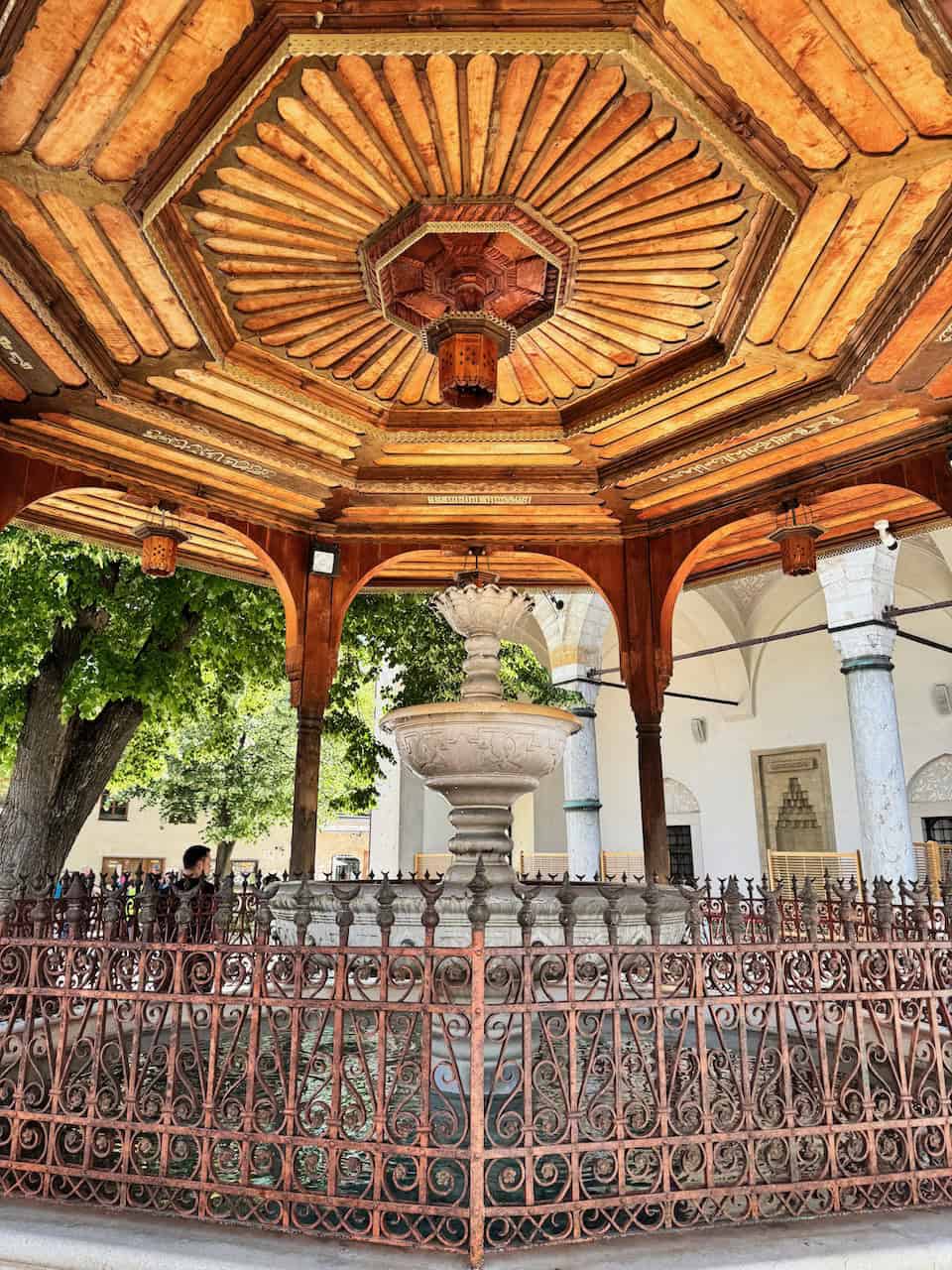
Across the road, you’ll find a museum, housed in the old madrasa (Islamic school) and the Library.
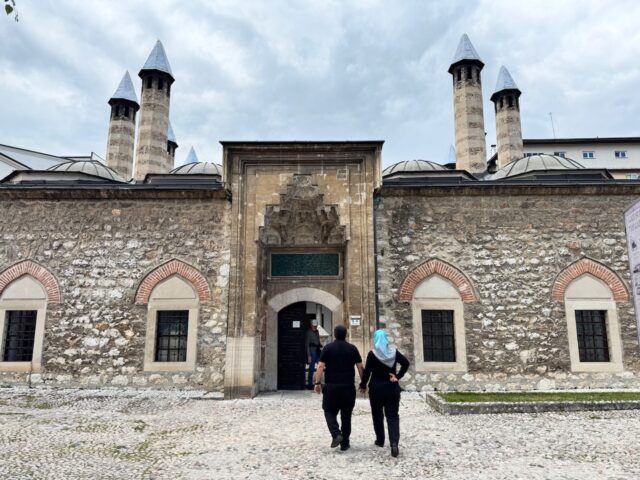
Lunar clock
Known as the only lunar clock in the world, this unique 16th century clock tower was also one of the structures built with Gazi Husrev-beg’s endowment. The clock uses Arabic numerals. ’12 o’clock’ indicates the moment of sunset, the Maghrib prayer time and end of the fasting time during the Ramadan (fasting month).
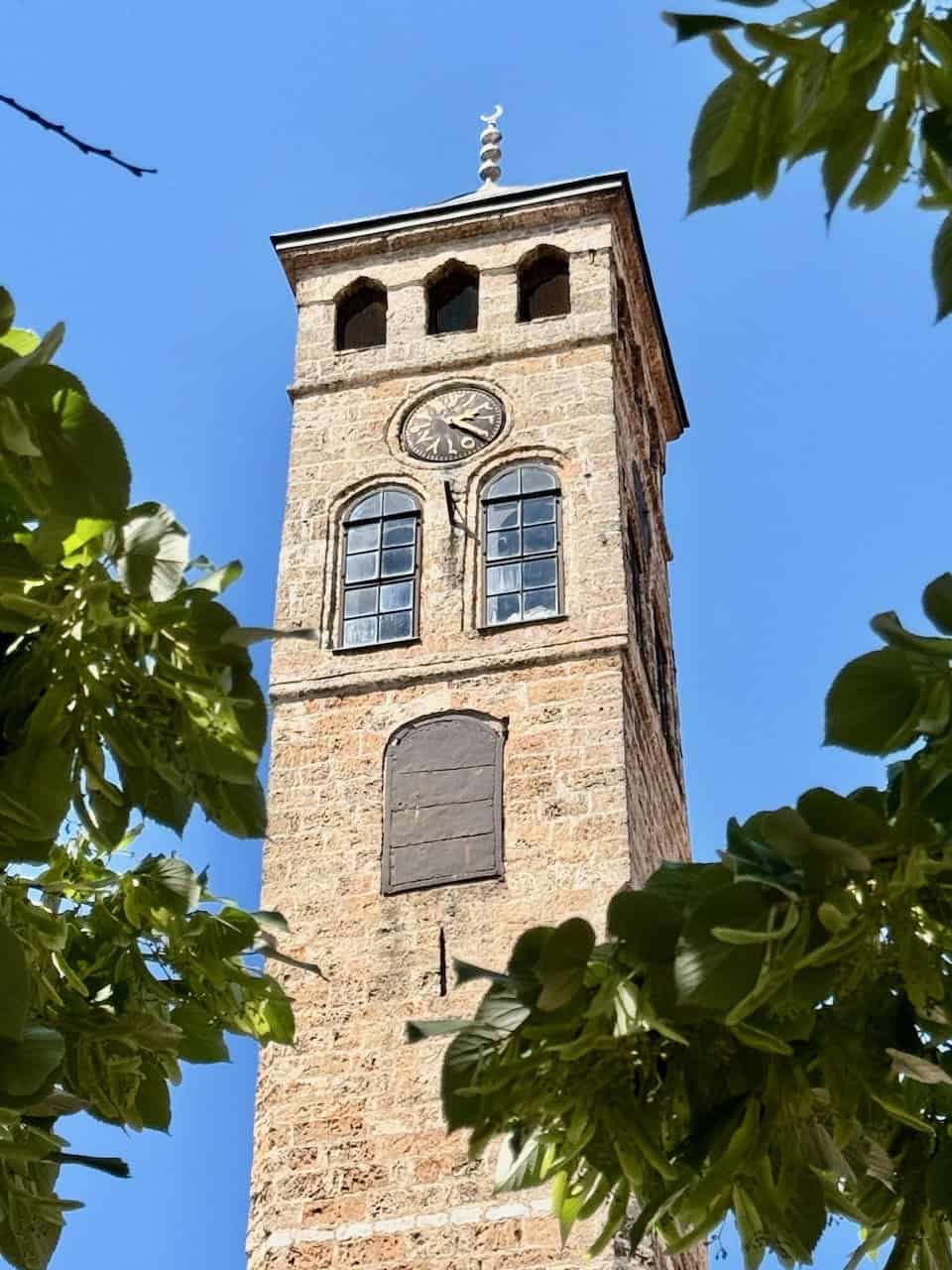
In 1874, the clock was replaced by a mechanism made by Gillett & Bland of London, the same company that built bell-and clock towers around the world such as the Manchester City Hall, St. Patrick’s Cathedral in Dublin, Sydney (Australia) Town Hall and even the Sultan Abdul Samad clock tower in Kuala Lumpur!
Morića Han
This is the oldest, still surviving, caravanserai (a medieval inn for merchants) in Sarajevo. Though it no longer houses merchants and their horses, it bursts with atmosphere, and is a great place to enjoy a cup of strong Bosnian coffee.


Bezistan
Another structure built with the endowment of Gazi Husrev-beg, Bezistan is a 16th century vaulted bazaar.
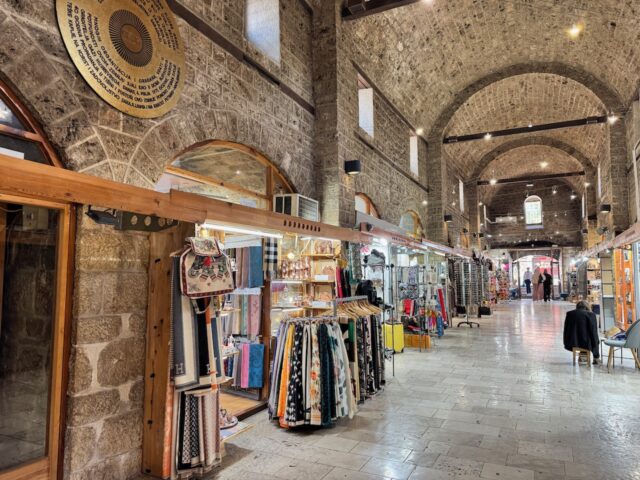
Tašlihan
Just outside Bezistan, you’ll find the ruins of an old caravanserai.
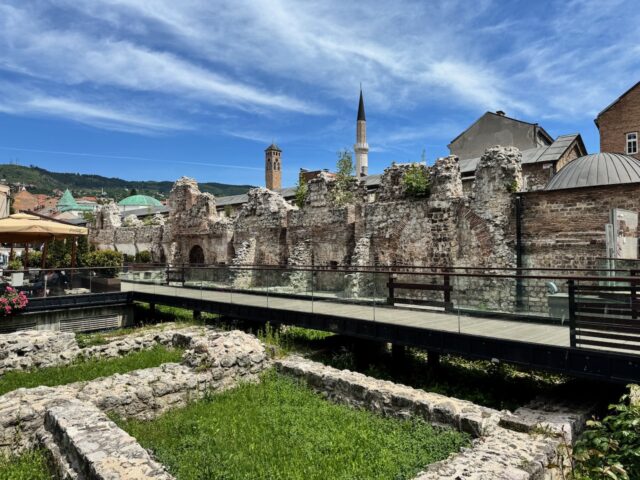
2. Cross the Meeting of Cultures point
Sarajevo truly is where East Meets West, and there’s even a line that marks the border between the Ottoman-era Baščaršija and the more modern Austro-Hungarian quarter. As you cross the line, notice the difference in the colour of the stone pavement: white on the Ottoman side and dark-grey on the Austro-Hungarian side. My guide swore that there’s actually a temperature difference in the summer as the dark-grey stone absorbs more heat.
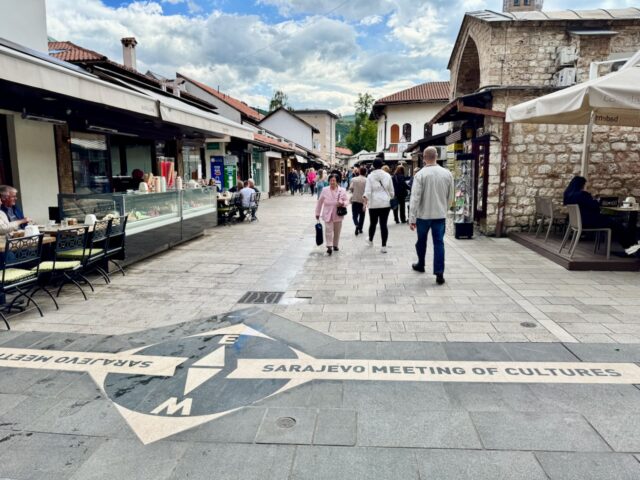
3. Explore the Austro-Hungarian quarter
A sharp contrast to Baščaršija, the Austro-Hungarian quarter boasts neat blocks of grand, neo-Renaissance mansions and Art Nouveau buildings.
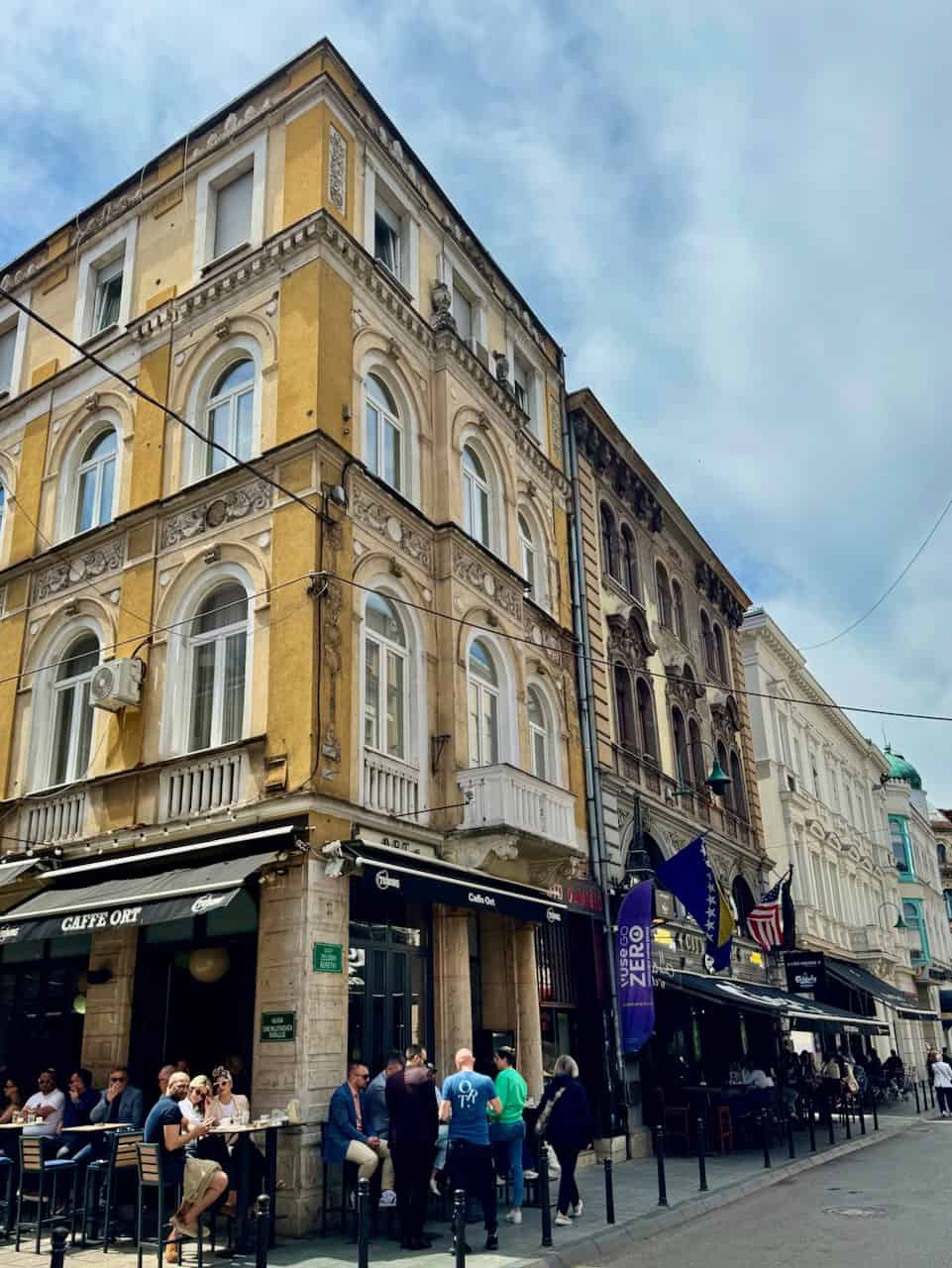
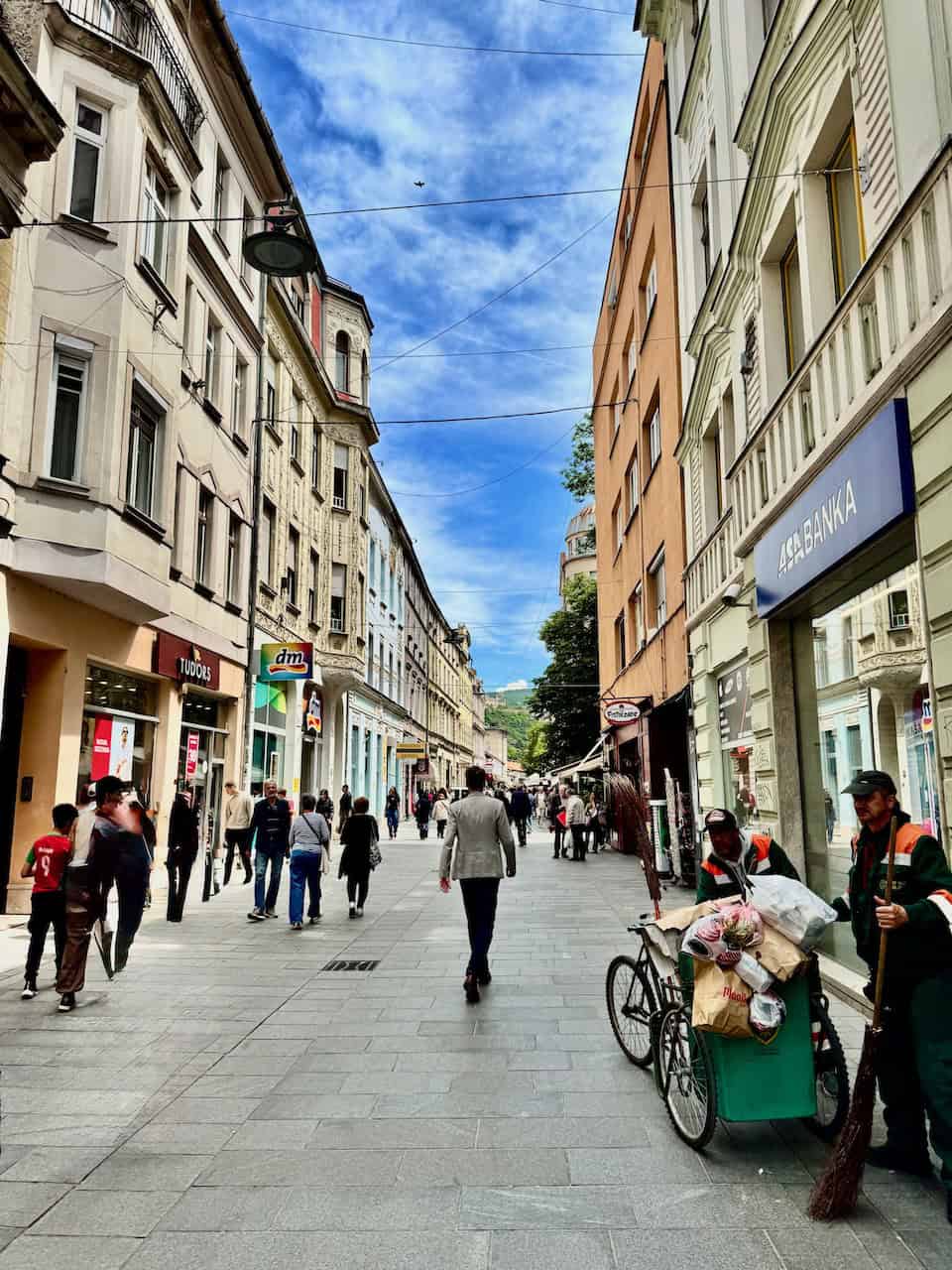
Within this quarter, you’ll find a plethora of shops, cafés, restaurants. Points of interest to look out for include:
Sacred Heart Cathedral (Roman Catholic)
The largest cathedral in Bosnia and Herzegovina was completed in 1887. Outside, you’ll find the statue of Pope John Paul II, who visited Sarajevo in 1997.

Cathedral Church of the Nativity of the Theotokos (Serbian Orthodox)
Completed in 1868, the church was built as a request from the city’s Serbian community, with funds raised by local Serbian merchants, and contributions from the Ottoman ruler as well as the Russian tsar.
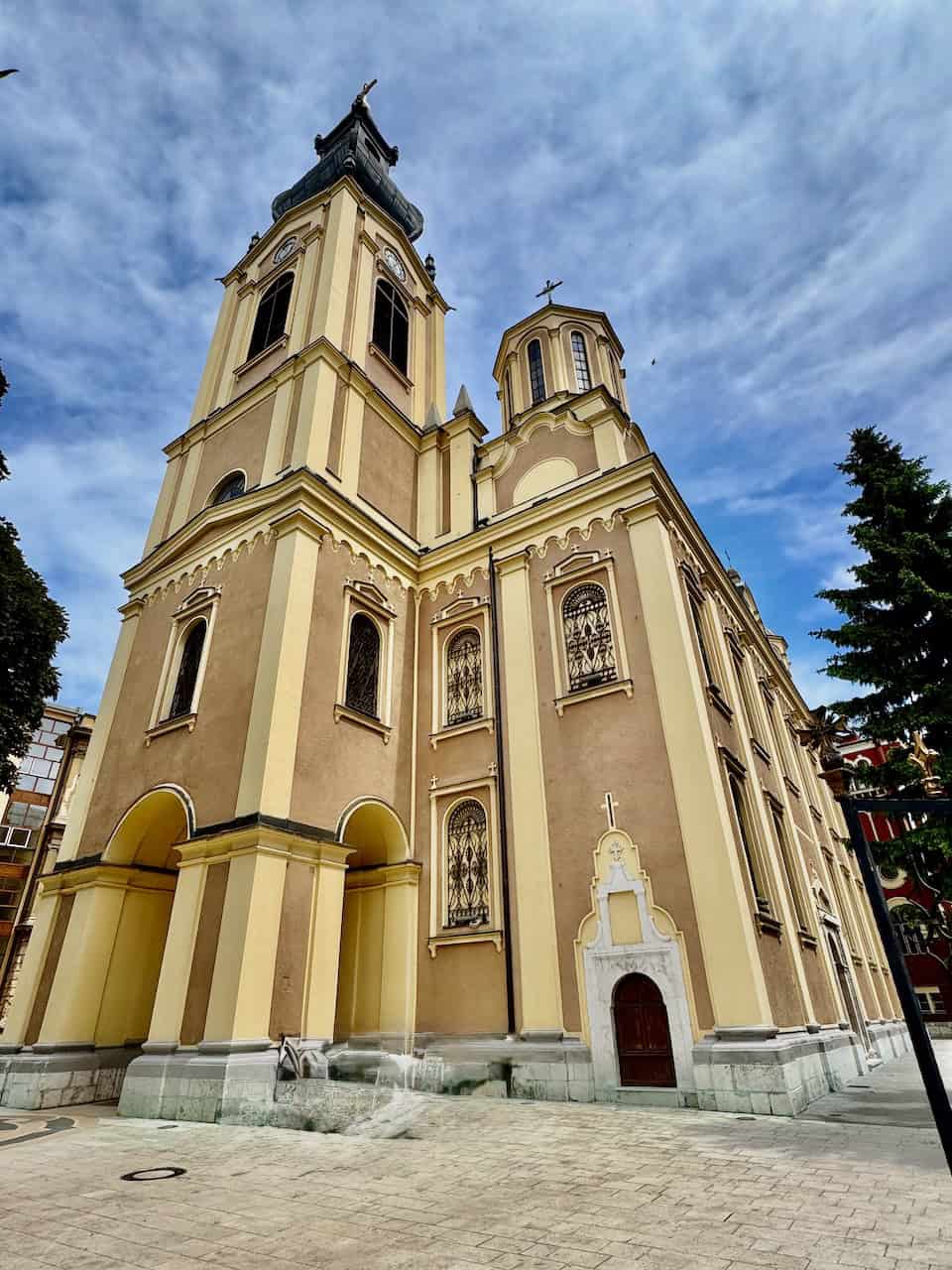
Eternal flame
A poignant memorial commemorating the victims of WWII.
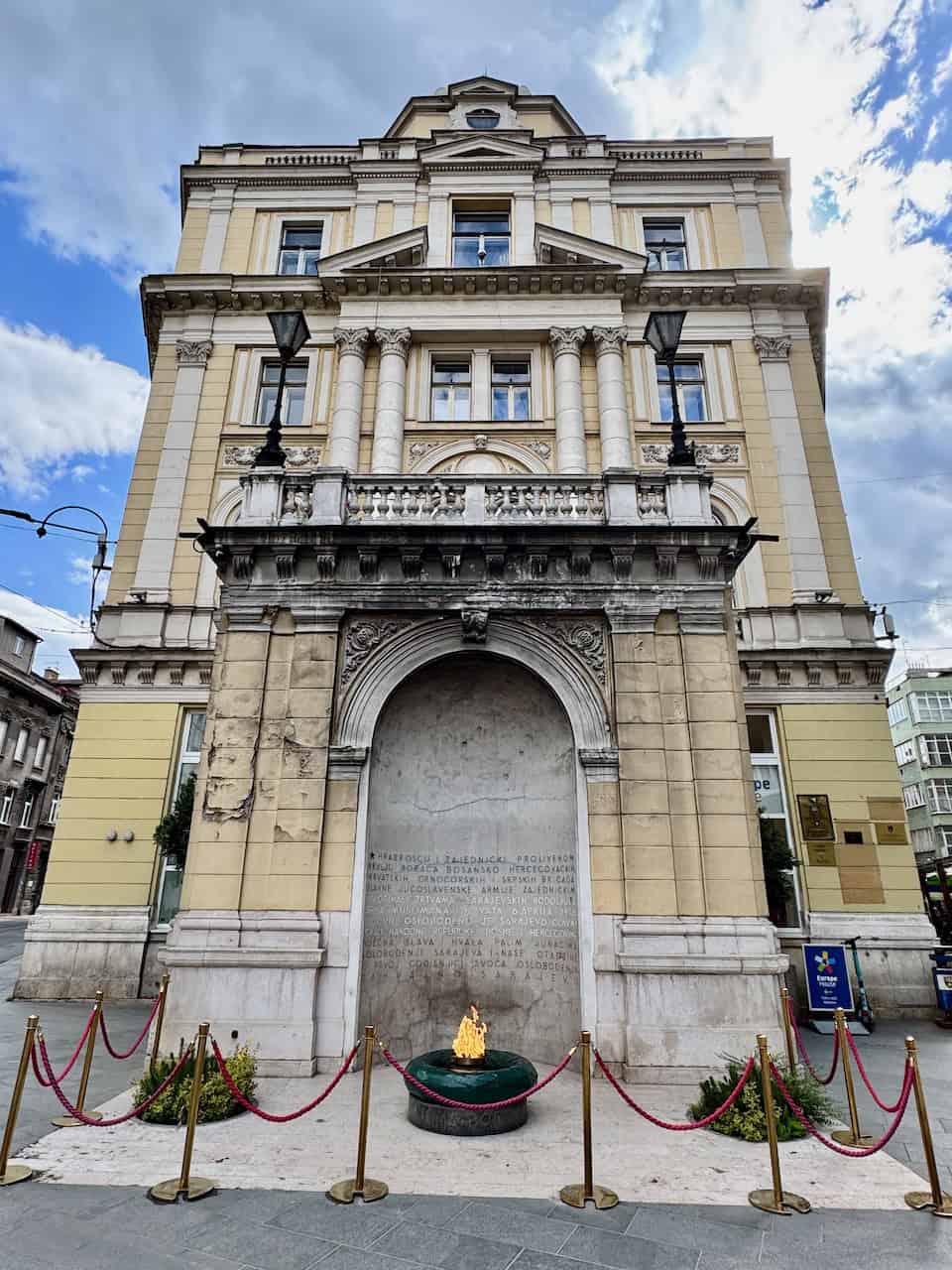
4. Experience the “Jerusalem of Europe”
With its congregation of places of worship representing multiple religions, Sarajevo certainly lives up to its name of being the “Jerusalem of Europe”. It really is possible to visit a synagogue, Catholic and Orthodox churches and a mosque within an hour. If this interests you, start at either the Gazi Husrev-beg Mosque or Ferhadija Mosque, then continue to the Sacred Heart Cathedral, followed by the Cathedral Church of the Nativity of the Theotokos, before ending at the Moorish-style Ashkenazi Synagogue across the river.

5. Visit the spot where Archduke Franz-Ferdinand was assassinated
The exact spot where Archduke Franz-Ferdinand was assassinated in 1914, an event which unleashed WWI, is not hard to find. Located across the road from the city’s iconic Latin Bridge, you’ll find a plaque and a car (a replica of the car the Archduke and his wife rode in) commemorating the spot. During a walking tour, the guide will tell you the pretty remarkable story of how the assassination took place.
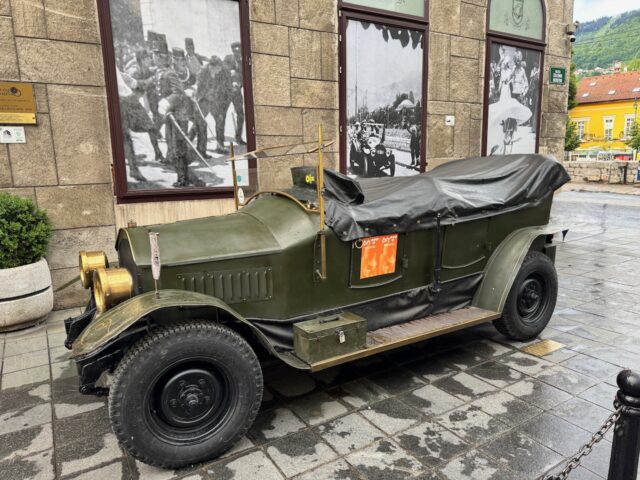
6. Cross the Latin Bridge
This 15th century Ottoman-era bridge, the city’s oldest, is somewhat of an icon of Sarajevo.
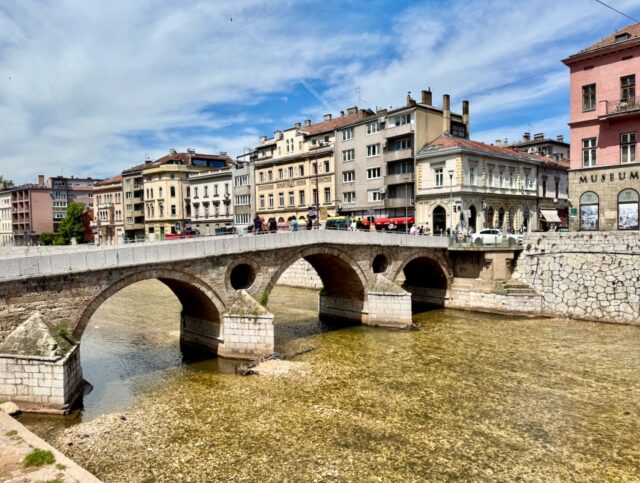
7. Visit the Emperor’s Mosque
Dedicated to the Ottoman Sultan, Mehmet The Conqueror, the Emperor’s Mosque was built in 1457, the first mosque to be built in Sarajevo after the Ottoman Conquest.
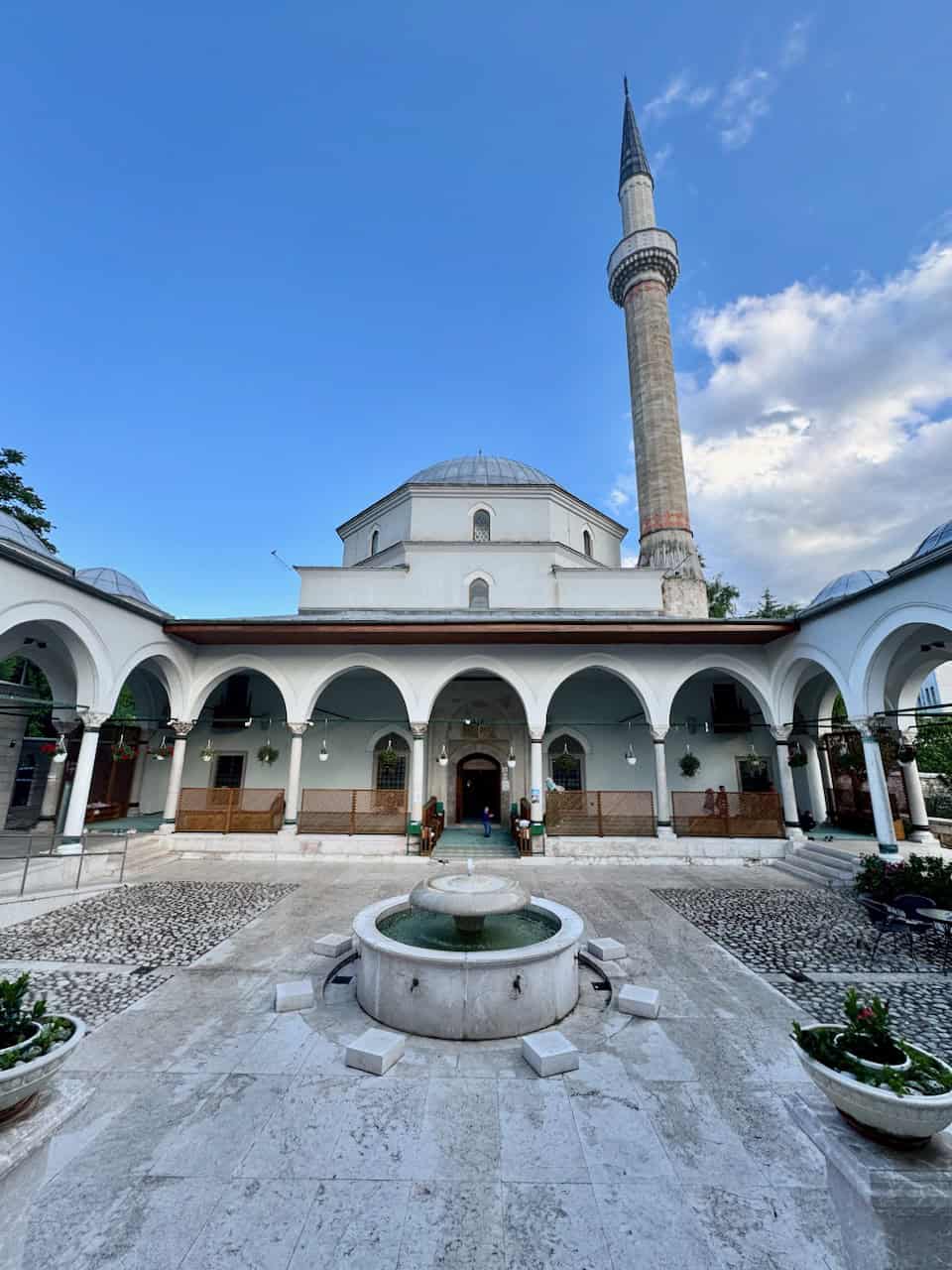
8. Visit the City Hall
Completed in 1896, the City Hall, built in the Moorish Revival style, is one of the most striking buildings in Sarajevo. Serbian military forces burnt it to the ground, along with its two million books (!), during the Siege of Sarajevo in the 1990’s. It was lovingly rebuilt and reopened in 2014. For a small entrance fee, you get to see the stunning interior, with its elegant Moorish arches and embellishments.
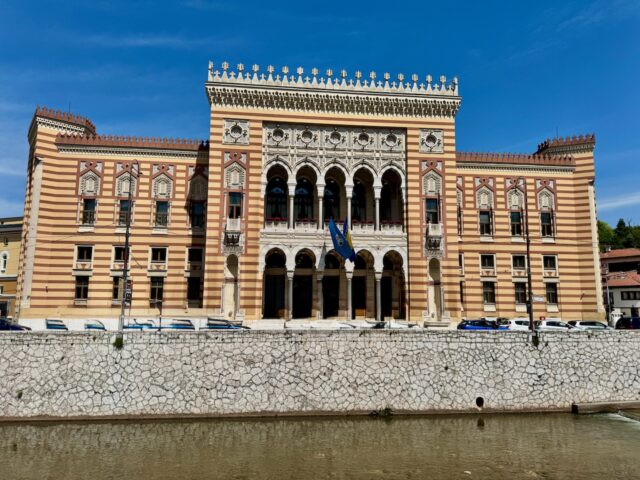
9. Enjoy the panoramic view from the Yellow Fortress
One of the top things to do in Sarajevo involves a climb to the Yellow Fortress. It’s a pretty steep hike but you’ll be rewarded with amazing views across the city. Locals love coming here to see the sunset.
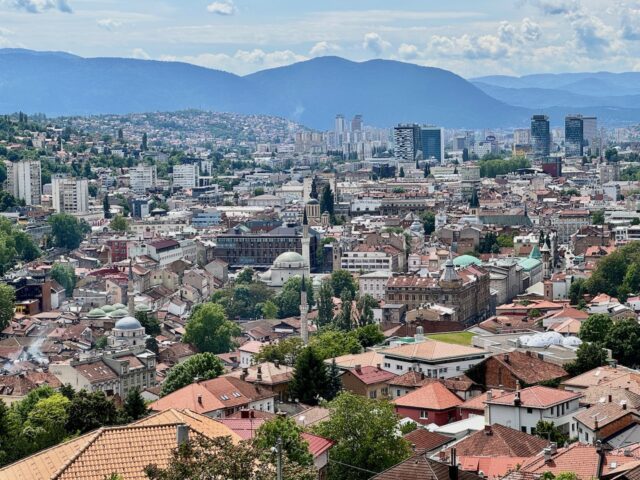
10. Browse the shops in Kazandžiluk
Kazandžiluk, the oldest street in Sarajevo, can be found in the Baščaršija quarter. This photogenic street, also called ‘Copperware Alley’, is packed with colourful shops selling coffee pots and sets, trays and all sorts of utensils. Drop by at Adnan’s copperware souvenir shop (map) to see him at work. The friendly and humorous smiths will gladly demonstrate their craft, and create a customised souvenir.
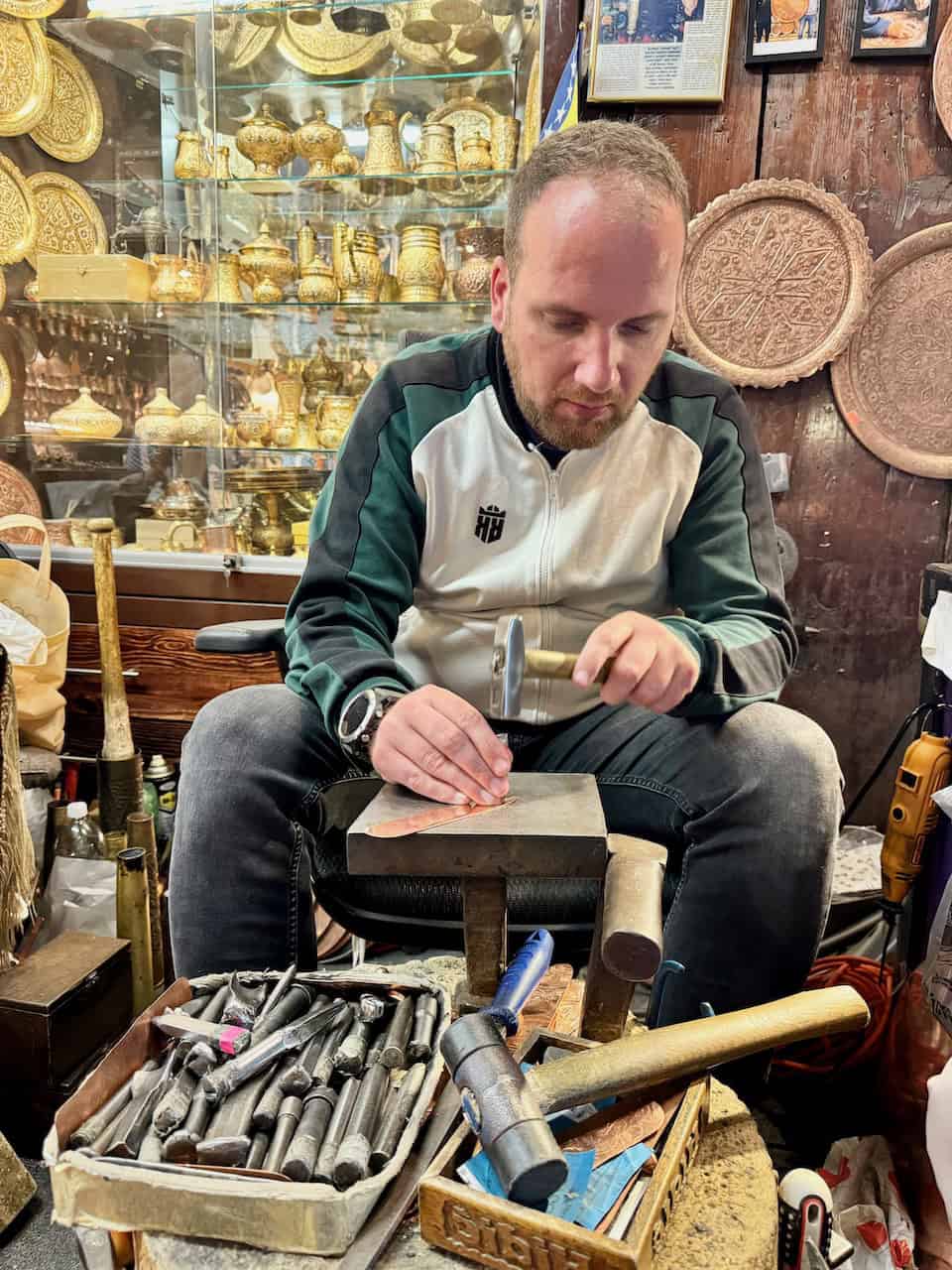
11. Indulge in Bosnian cuisine
Bosnian cuisine was not known to me before my visit but I soon discovered some favourite dishes, like cevapi! Theses minced meat fingers, served with bread and a cheese spread, is absolutely delicious. My go-to place for cevapi was Nune, a cosy, family-owned place.
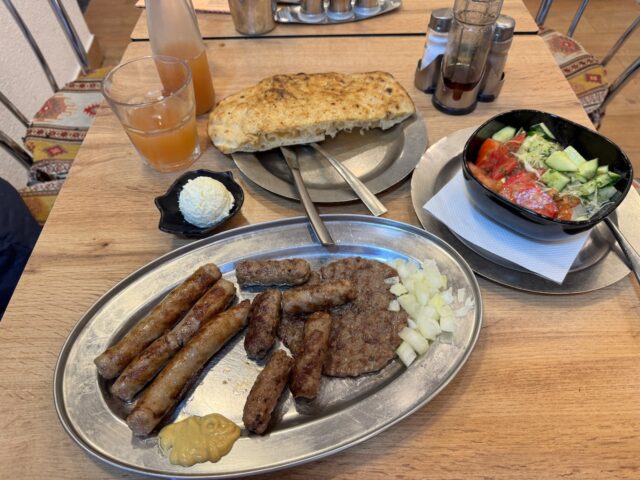
For a good introduction to Bosnian cuisine, check out ASDŽ Aščinica, that serves a wide variety of traditional Bosnian dishes. I was a regular visitor during my week-long stay in Sarajevo!
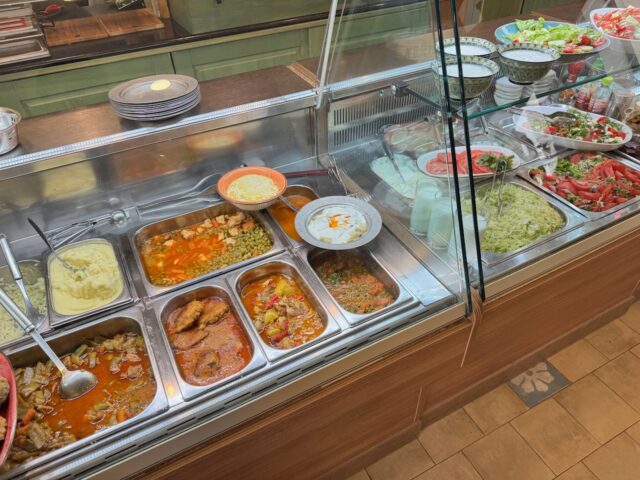
Another Bosnian specialty is burek, flaky pastries stuffed with meat, cheese, spinach or potatoes. A great place to try these ‘Bosnian pies’ is Buregdžinica Sač.

If you have a sweet tooth, you’re in the right place as Bosnians love their sweets and desserts! Unfortunately, or perhaps, fortunately, I don’t, but I absolutely loved the baklava at Baklava Ducan, a serving of which was sufficient to cover my weekly sugar intake!
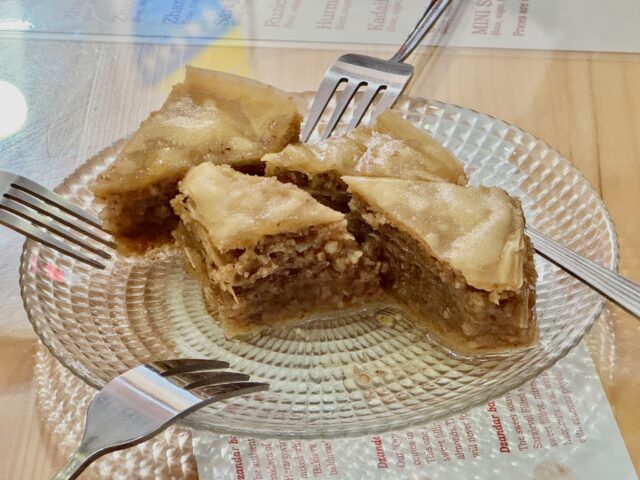
One of the best things to do in Sarajevo for foodies is to join a food tour. It’s a great introduction to the country’s cuisine and you’ll leave with a full tummy and several doggy bags!
12. Learn more about the Siege of Sarajevo
During the Bosnian War in the early 1990s, Sarajevo endured a brutal 1,425-day siege by Serbian military forces, the longest of any city in modern history. The scars of this horrific chapter remain visible today, from war memorials, museums, and cemeteries to buildings still marked by bullet holes.
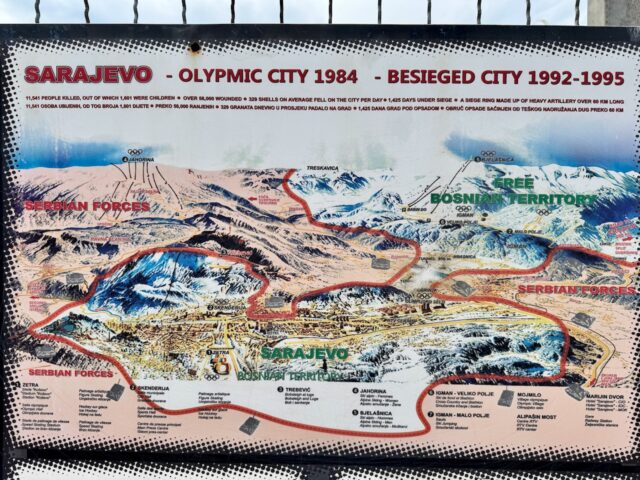
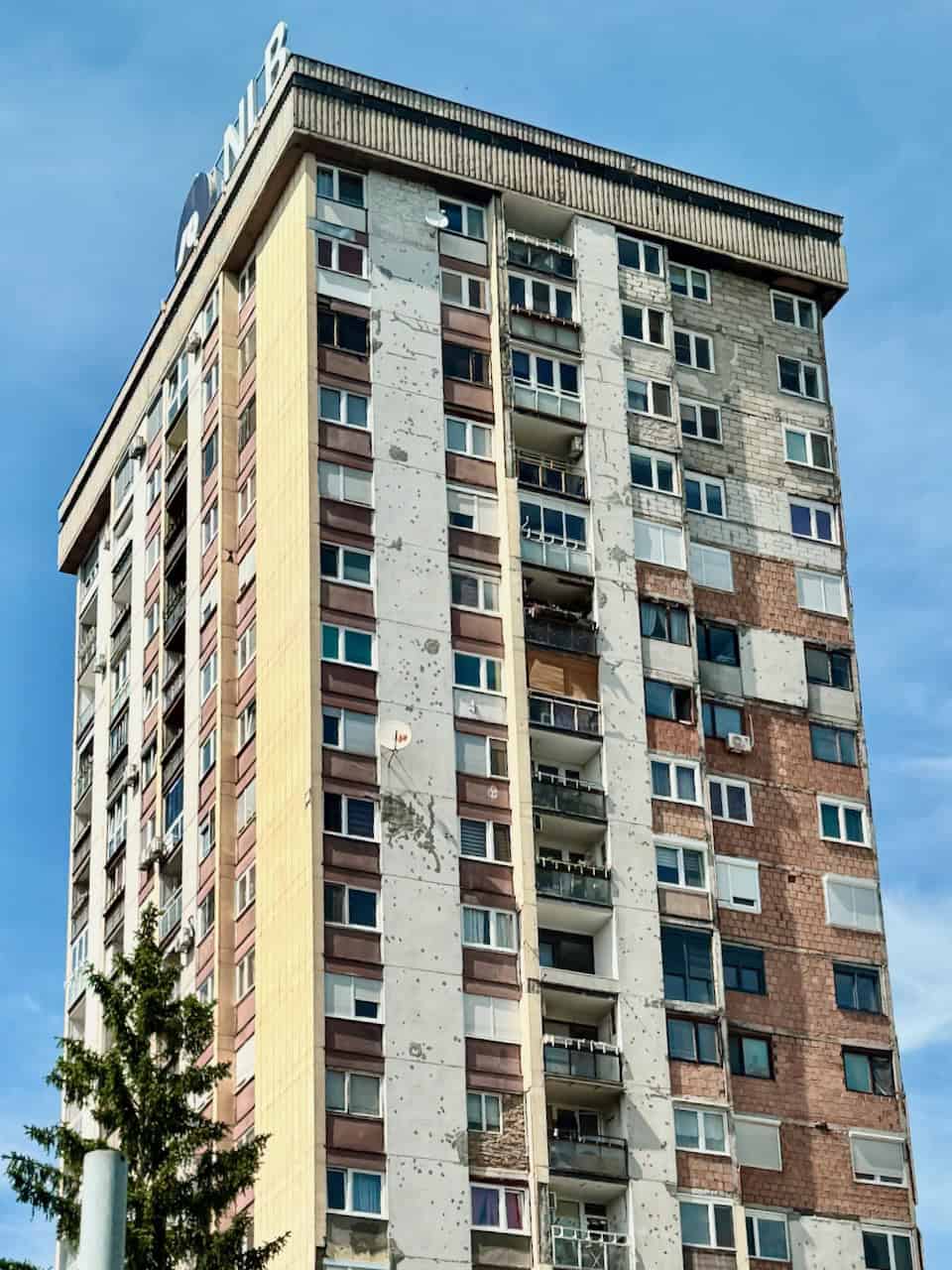
During my various tours in Sarajevo and Bosnia, the tour guides never shied away from talking about the war and what they and their families endured. To gain a better understanding, I joined the Siege of Sarajevo and Fall of Yugoslavia tour. It’s a tour I highly recommend. Despite the heaviness, there was a quiet sense of resilience in every stop, a reminder of how deeply Sarajevo had suffered and how bravely it had survived.
13. Visit the Tunnel of Hope
During the Siege of Sarajevo, the city was almost completely surrounded by Serbian military forces. Near the airport, Bosnian forces secretly dug an 800-metre tunnel that extended under the runway to an area controlled by Bosnian forces and the United Nations. This tunnel was used to smuggle people, food and weapons during the Siege. A museum now marks the site and there’s a short stretch of the tunnel that can be visited.
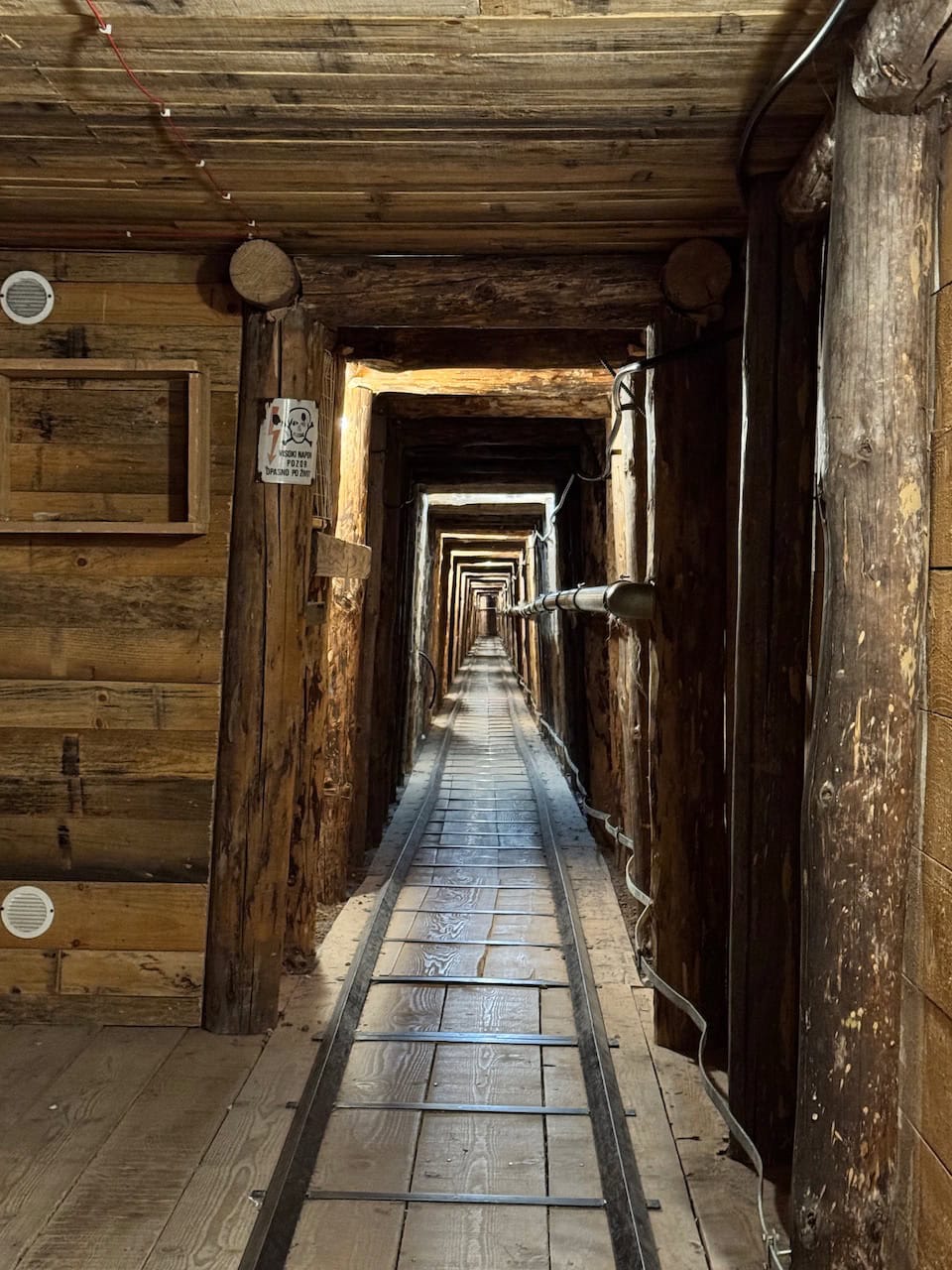
14. Take the cable-car to the top of Mt. Trebević
A fun and scenic thing to do in Sarajevo is to take the cable-car to the top of Mt. Trebević. Panoramic views of Sarajevo await at the top, and a short walk away, you’ll find the old bobsleigh track used during the 1984 Winter Olympics.
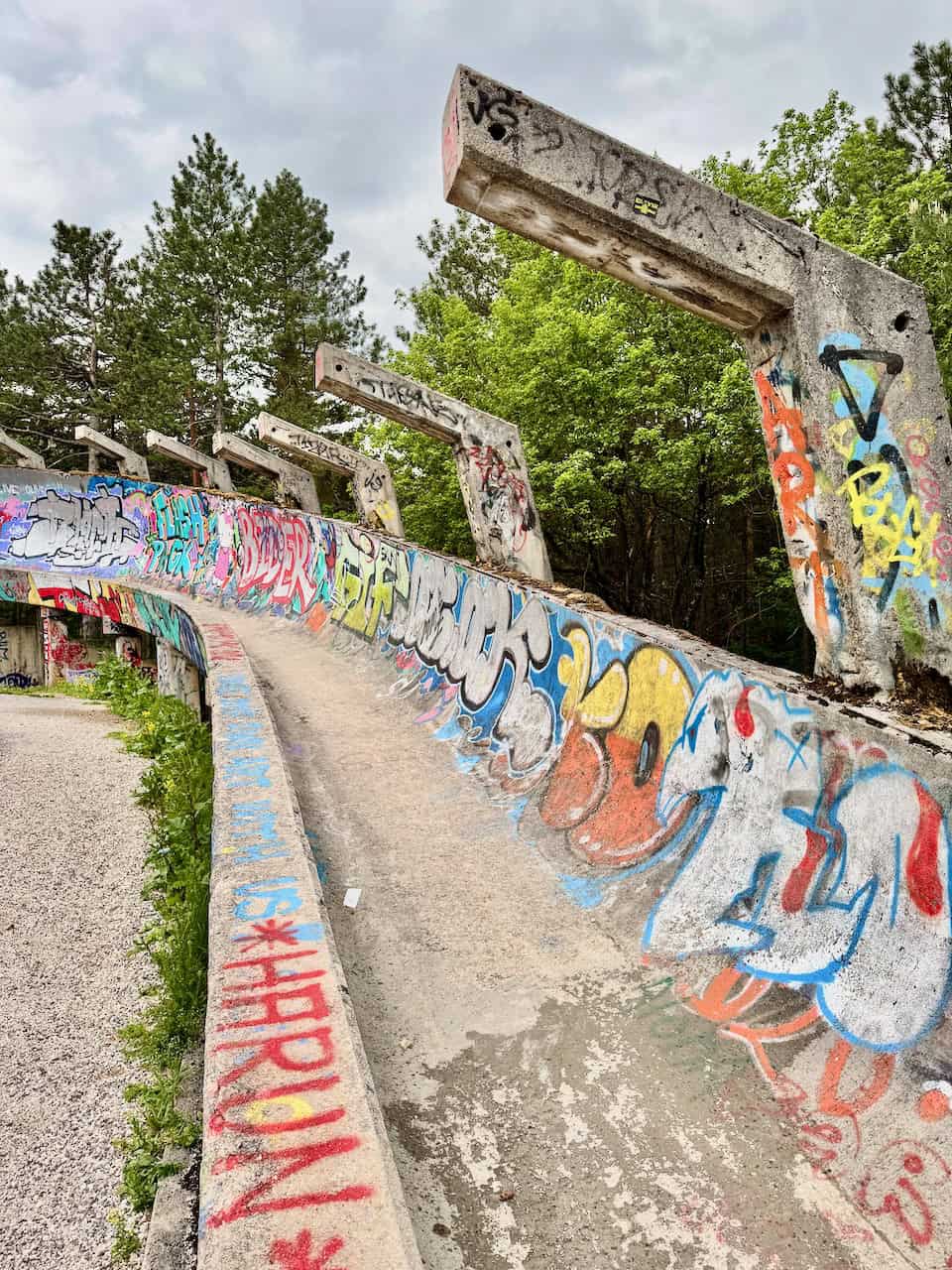
15. Mingle with the locals
During my week in Sarajevo, I discovered a warm and friendly people who are only too eager to strike up a conversation. Many of them speak English so it was easy to chat. I visited numerous cafés and bars where I quickly found myself in a conversation with locals and other tourists.
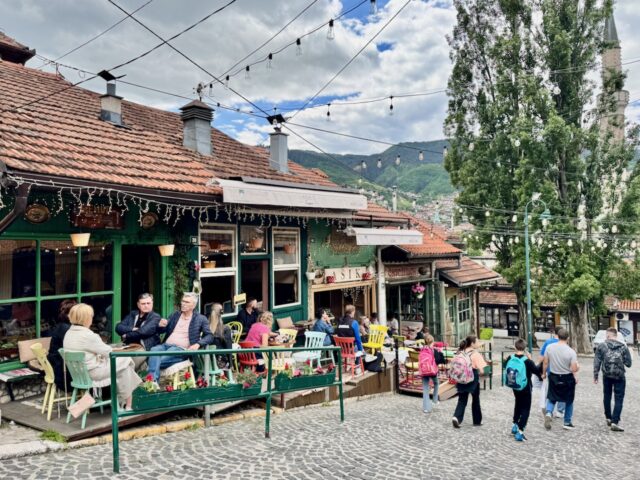
Some of my favourite places include Caffe Divan (Morića Han) and Caffe Selfie in Baščaršija, and La Cava Pub, Central Caffe, Behut Coffeeshop, City Pub and Tesla Pub (I’ve pinned these places in the map below). These are easy-going places to have a coffee, a beer or a cocktail, watch the world go by and mingle with the locals.
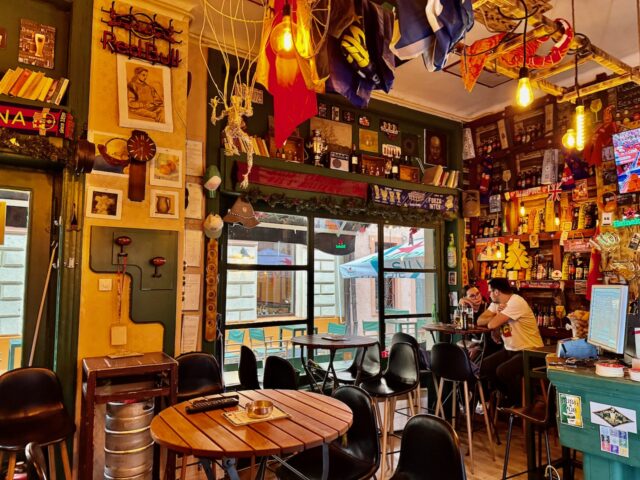
16. Visit the historic markets
If you love visiting markets, like I do, then don’t miss Pijaca Markale and Gradska Tržnica, Sarajevo’s historic markets.
During the Siege of Sarajevo, the Pijaca Markale was shelled multiple times, attacks which killed dozens of civilians. These days, it’s a colourful market with friendly vendors selling a variety of vegetables and fruits.
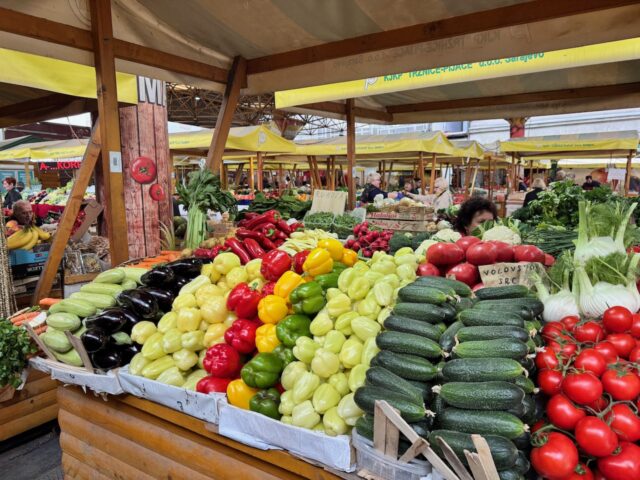
A short walk away, stands the grand Gradska Tržnica indoor market hall. During my first day in Sarajevo, I actually mistook it for a concert hall! Built in 1895 during the Austro-Hungarian period, the Gradska Tržnica was a marvel of its time, featuring Sarajevo’s first steel-girder roof. Over a century later, it still functions as a bustling local market, with neatly arranged stalls offering everything from fresh fruits to meats, cheeses and artisanal treats.
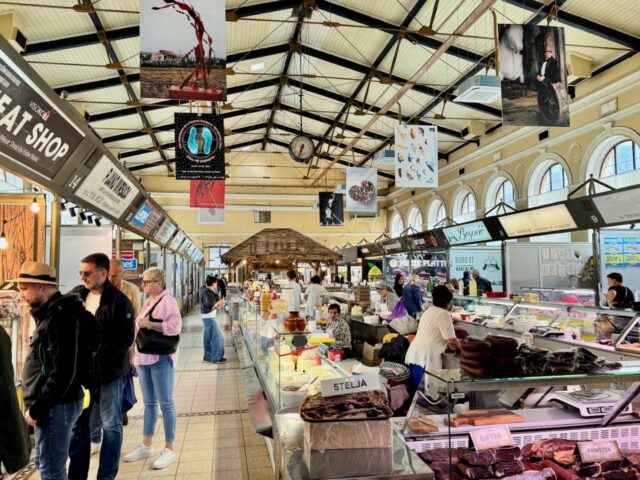
17. Spot the Sarajevo Roses
During my walks around the city, I noticed numerous, curious-looking splatters of paint on the pavements. I later learned that these are the Sarajevo Roses. During the Siege of Sarajevo, the city was bombarded with hundreds of mortar shells every day. The explosion marks or craters were later filled with red resin as a memorial of those who perished on the spot. These little memorials became known as the Sarajevo Roses.
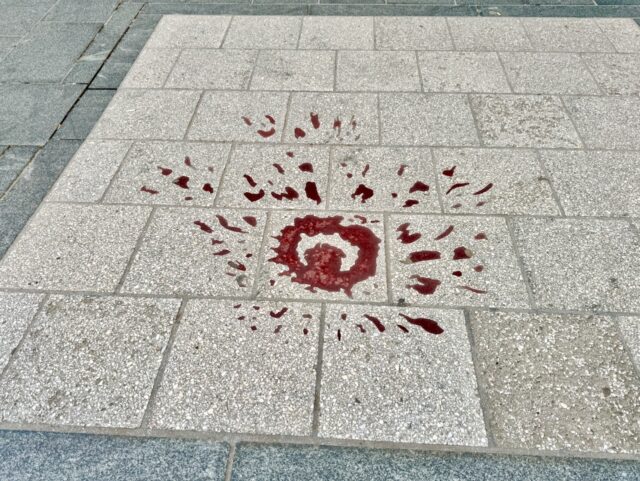
18. Have a hammam experience
Finally, indulge yourself in a traditional hammam experience at the Isa Begov Hamam Hotel, a beautifully restored hotel/hammam near the Latin Bridge. After days of walking and sightseeing, the steam and scrub left me feeling completely renewed. I’ve visited hammams in Morocco, Jordan and Turkey, and this experience ranks among the best of them.
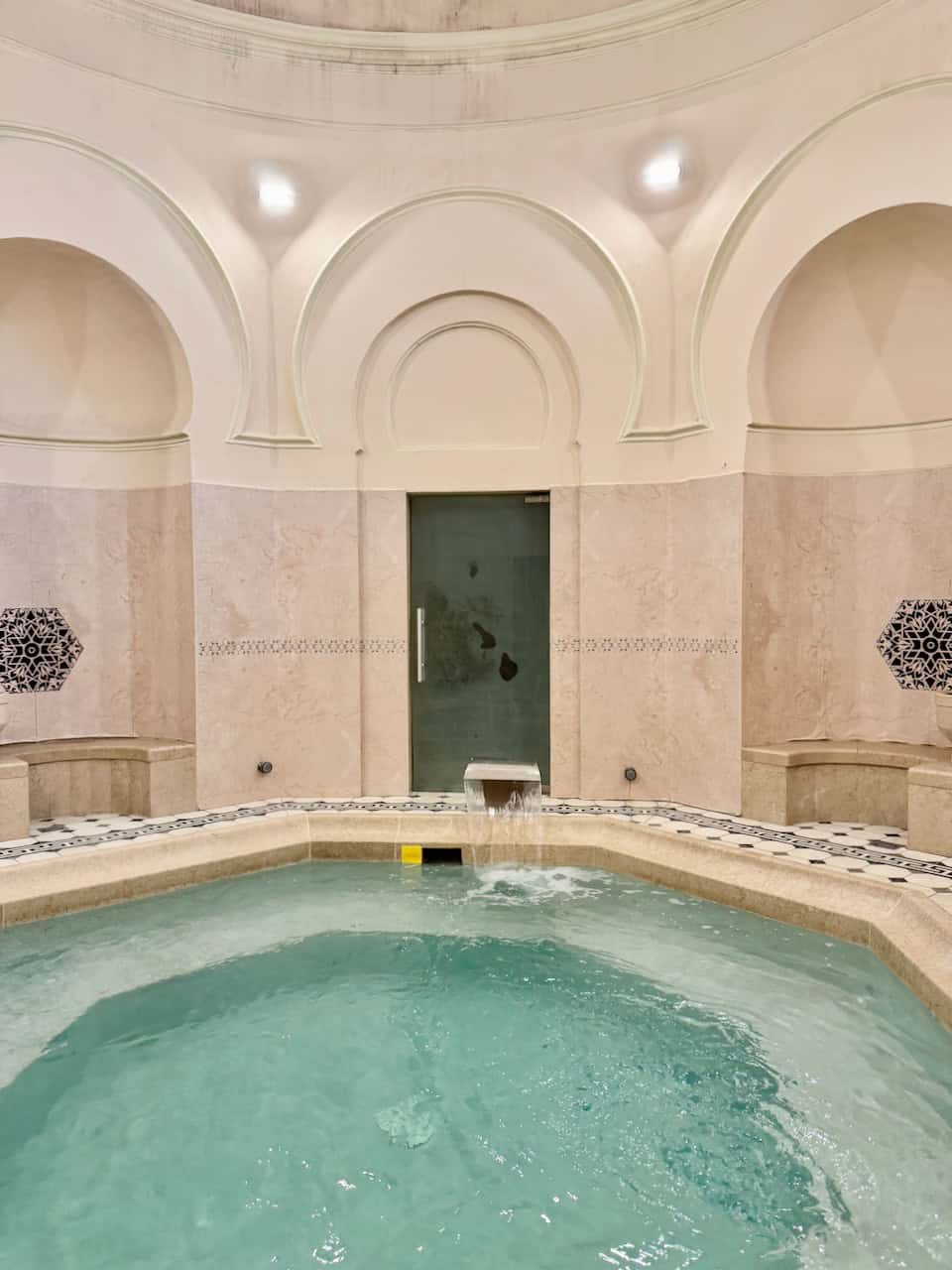
Places to visit in Sarajevo (map)
I’ve pinned the places mentioned above on the map below:
Sarajevo FAQ
How to get to Sarajevo?
Sarajevo has an international airport with frequent flights to major European hubs as well as farther afield, such as Dubai. The airport is located about 20 minutes from the city centre. There are also many bus lines which connect Sarajevo with other European cities. A train service connects Sarajevo with Zagreb, Croatia.
What currency is used in Sarajevo?
The Bosnian currency is called the convertible mark, which trades at a fixed rate to the euro (0.51 euro for 1 mark). Many restaurants accept euros and credit cards – check in advance to be sure. There are also many ATMs and currency exchange booths in the Old Town.
Is Sarajevo an affordable destination to visit?
Accommodations in Sarajevo are relatively cheap compared to Western European cities. In addition, food and drinks are very reasonably priced. I often ate (well) for around 20 marks.
Is Sarajevo safe?
I was on my own most of the time and never felt unsafe. I did spot signs warning of pickpockets and phone-snatchers in the Old Town, so be aware of your belongings.
How do I get around Sarajevo?
Sarajevo has a public transportation system that comprises trams and buses. Tickets can be purchased from kiosks or the driver. However, the Old Town is best explored on foot.
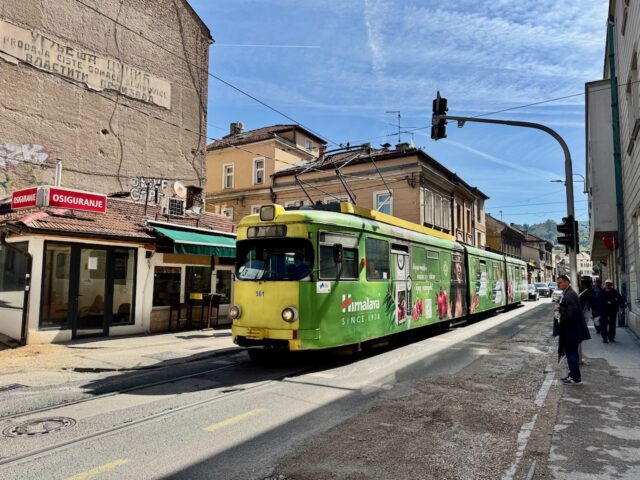
Note: my visit to Sarajevo was made possible by Meet Bosnia Tours. As always, all opinions above are mine.
velvetescape.com (Article Sourced Website)
#Sarajevo
